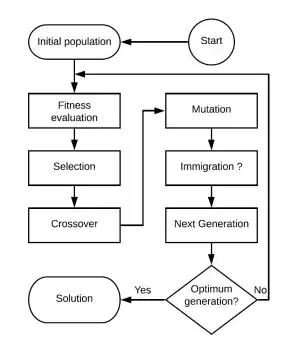Related Work
Optimal Power Flow (GAOPF) problem is solved based on the use of a genetic algorithm load flow,
and to accelerate the concepts it propose the use of gradient information by the use of the
steepest decent method. The method is not sensitive to the starting points and capable to
determining the global optimum solution to the OPF for range of constraints and objective
functions. But GAOPF requires two load flow to be performed per individual, per iteration
because all controllable variables are included in the fitness. In this paper we develop a
simple genetic algorithm applied to the problem of optimal power flow in large power
distribution systems. To accelerate the processes of GAOPF, the controllable variables are
decomposed to active constraints that effect directly the cost function are included in the
Genetic algorithms process and passive constraints which are updating using a conventional load
flow program, only, one time after the convergence on the GAOPF. In which the search of the
optimal parameters set is performed using into the account that the power losses are 2% of the
power demand. The slack bus parameter would be recalculated in the load flow process to take the
effect of the passive constraints.
Description of Genetic Algorithms
The genetic algorithms are part of the evolutionary algorithms family, which are computational
models, inspired in the Nature. Genetic algorithms are powerful stochastic search algorithms
based on the mechanism of natural selection and natural genetics. GAs works with a population of
binary string, searching many peaks in parallel. By employing genetic operators, they exchange
information between the peaks, hence reducing the possibility of ending at a local optimum. GAs
are more flexible than most search methods because they require only information concerning the
quality of the solution produced by each parameter set (objective function values) and not lake
many optimization methods which require derivative information, or worse yet, complete knowledge
of the problem structure and parameters.
There are some difference between GAs and traditional searching algorithms. They cold be
summarized as follows:
- The algorithms work with a population of string, searching many peaks in parallel, as
opposed to a single point.
- GAs work directly with strings of characters representing the parameters set not the
parameters themselves.
-
GAs use probabilistic transition rules instead of deterministic rules.
-
GAs use objective function information instead of derivatives or others auxiliary knowledge.
-
GAs have the potential to find solutions in many different areas of the search space
simultaneously.

PROBLEM FORMULATION
The standard OPF problem can be written in the following form,
Minimise F(x) (the objective function)
subject to :
hi(x) = 0, i = 1, 2, ..., n (equality constraints)
gj(x) = 0, j = 1, 2, ...,m (inequality constraints)
where x is the vector of the control variables, that is those which can be varied by a control
center operator (generated active and reactive powers, generation bus voltage magnitudes,
transformers taps etc.);
The essence of the optimal power flow problem resides in reducing
the objective function and simultaneously satisfying the load flow equations (equality
constraints) without violating the inequality constraints
Item 1 is a part of the problem's input data and all the features in items 2 and 3 are
A. Objective Function
The most commonly used objective in the OPF problem formulation is the minimisation of the total
cost of real power generation. The individual costs of each generating unit are assumed to be
function, only, of active power generation and are represented by quadratic curves of second
order. The objective function for the entire power system can then be written as the sum of the
quadratic cost model at each generator.

where ng is the number of generation including the slack bus. Pgi is the generated active power
at bus i. ai, bi and ci are the unit costs curve for ith generator.
B. Types of equality constraints
While minimizing the cost function, its necessary to make sure that the generation still
supplies the load demands plus losses in transmission lines. Usually the power flow
equations are used as equality constraints.

where active and reactive power injection at bus i are defined in the following equation:



